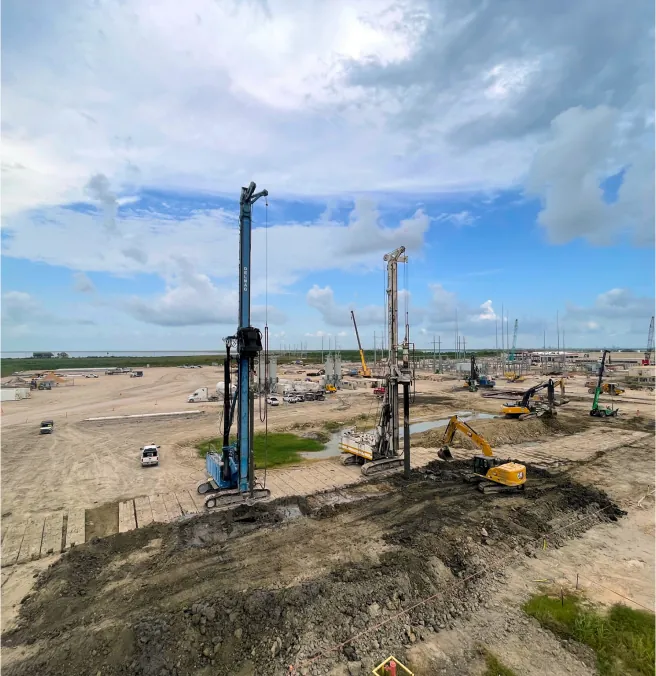Deep Soil Mixing
When it comes to Deep Soil Mixing (DSM), no company has broader capabilities or more experienced Associates than ENTACT. We self-perform all DSM work, providing reliability and accountability that clients can count on for schedule and cost control, no matter the size of your project. We conduct our own treatability studies and mix designs within our in-house laboratory to ensure quality control remains consistent and reliable. To date, ENTACT is the most prolific soil mixer in the United States, having performed more than 15,000,000 CY of soil mixing.
What is Deep Soil Mixing
DSM is a ground modification technique used in geotechnical construction to strengthen and stabilize weak or loose soils. It involves mechanically mixing or injecting a binder (such as cement, cement blended with slag, bentonite or other reagents) into the soil to alter its engineering properties and enhance its load-bearing capacity or reduce its permeability.
Soil improvement work typically begins with the insertion of a mixing tool, such as an auger, into the soil. As the tool is rotated and advanced into the ground, it mixes the binder with the soil, creating a homogeneous mixture. This process can be carried out to various depths depending on the project requirements. After DSM, soil results in overall reinforcement of soil, including increased strength, stiffness, and durability with decreased permeability and leachability.
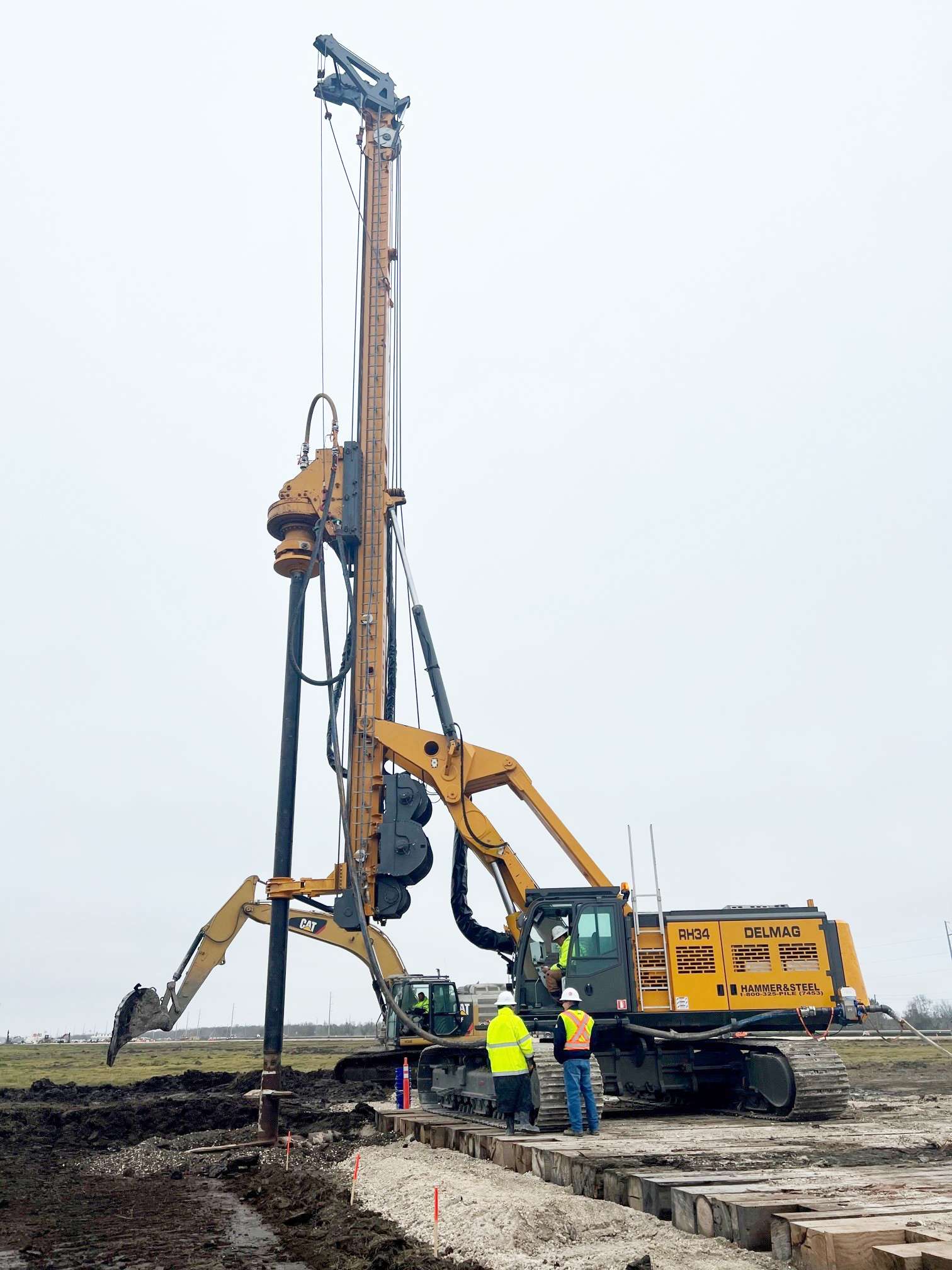
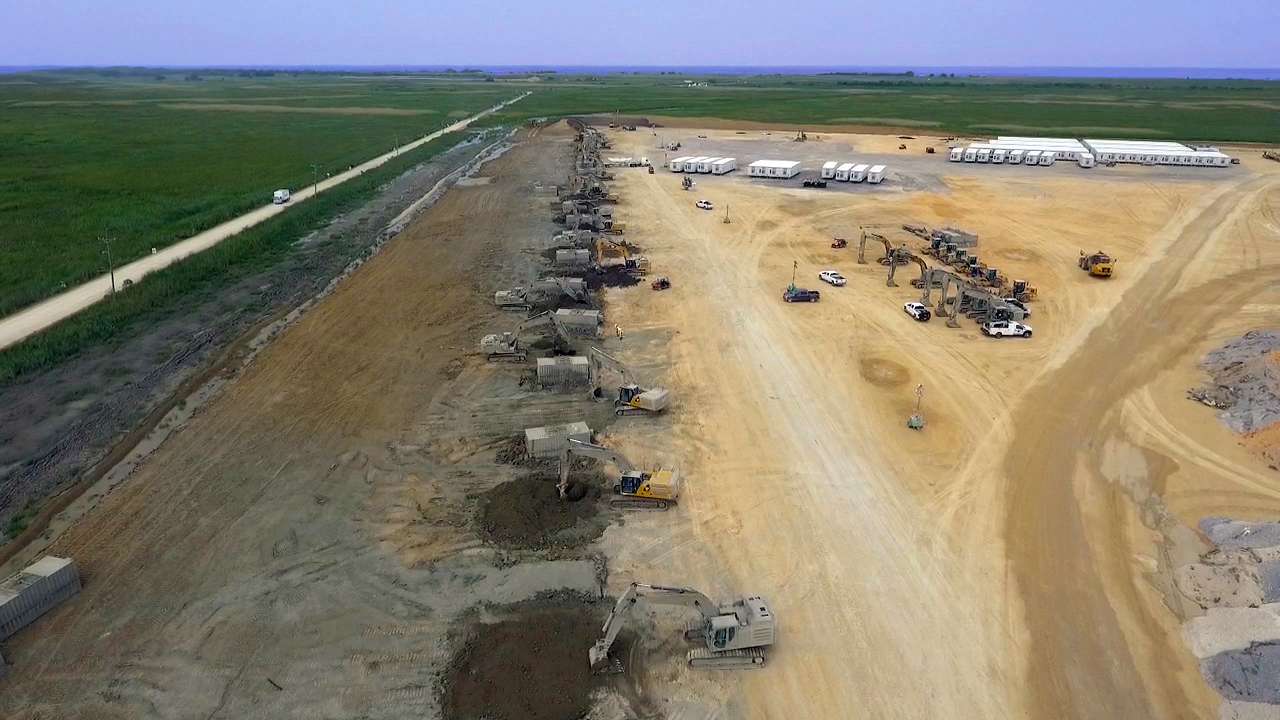
Uses for Deep Soil Mixing
DSM is commonly used for a wide range of geotechnical construction applications. First and foremost, DSM is used for ground modification and improvement, reinforcing weak or loose soils to increase their bearing capacity and improve foundation support. DSM is also utilized to reduce settlement or movement, especially to strengthen slopes and provide erosion protection. Another reason ENTACT uses DSM is to install earth retention systems and cutoff walls to prevent water from flowing through porous soils or to contain contaminants from migrating.
Deep Soil Mixing Techniques
At its core, DSM involves the mechanical blending of binders into existing soil to modify its properties and enhance its load-bearing capacity. This process can be executed through various methodologies, each tailored to specific project requirements and soil conditions.
Vertical Auger Mixing
Utilizing rotating augers, vertical auger mixing penetrates deep into the soil, thoroughly blending binders to create a homogenous mixture. This method is particularly well-suited for projects requiring substantial soil improvement work at significant depths, such as stabilizing weak foundations or reinforcing deep excavation sites.
Excavator Bucket Mixing
On projects with space constraints or limited access with shallower treatment depths, excavator bucket mixing offers a practical solution. Mounted on excavators, mixing buckets are employed to blend binders into the soil horizontally. This method provides flexibility and efficiency, making it ideal for urban construction sites or areas with restricted maneuverability.
In-situ Solidification and Stabilization (ISS)
Precision meets performance with in-situ solidification and stabilization, a technique that involves injecting binders directly into the soil through specialized equipment. By controlling the injection process, our team can tailor the mixture to meet specific project objectives, whether it’s remediation of contaminated sites, soil stabilization, creation of cutoff walls, support of excavation, or mat/wide-area foundation improvements.
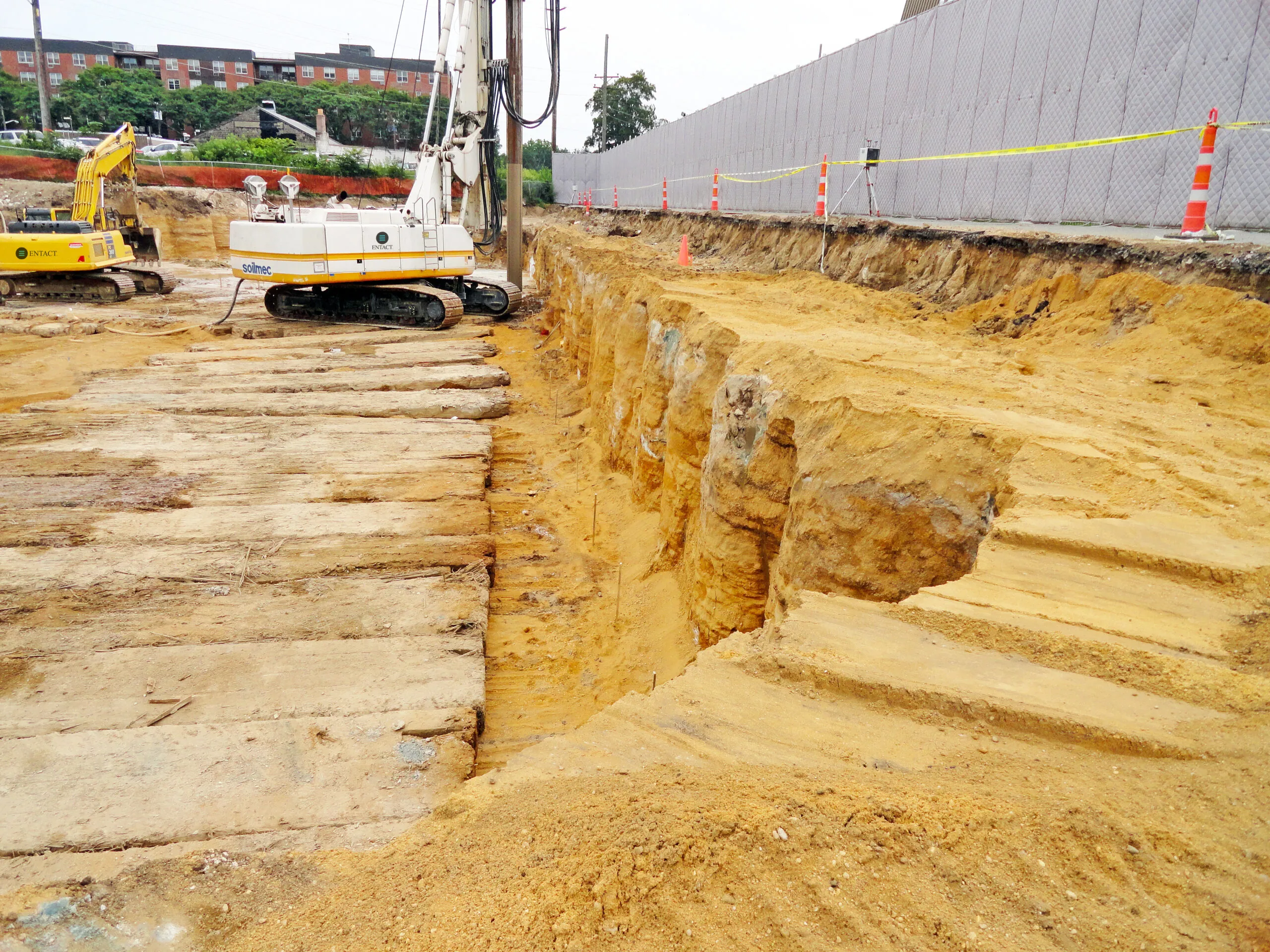
Advantages of Deep Soil Mixing
DSM offers a wide variety of advantages over traditional ground modification methods, making it a preferred choice for ground improvement.
Enhanced Load-Bearing Capacity
By reinforcing soil with binders like cement, lime, or polymer-based additives, DSM significantly increases the soil’s bearing capacity, allowing it to support heavy structures and infrastructure with confidence.
Environmental Remediation
DSM serves as a potent tool for environmental remediation, effectively containing contaminants within the soil matrix and preventing their migration into groundwater or surface water bodies. This capability makes DSM indispensable for brownfield redevelopment and ecosystem restoration projects.
Versatility and Adaptability
With multiple methodologies and a diverse range of additives at our disposal, DSM offers unparalleled versatility, catering to a wide spectrum of soil types, project requirements, and environmental conditions. However, there are several design considerations that affect the ways in which we use DSM, including target soil properties, desired/required end use, achievable soil strength, remediation goals, and more.
Minimal Site Disruption
Unlike traditional ground improvement techniques that may require extensive excavation or disruption, DSM minimizes site disturbance, enabling construction activities to proceed smoothly while mitigating environmental impact.
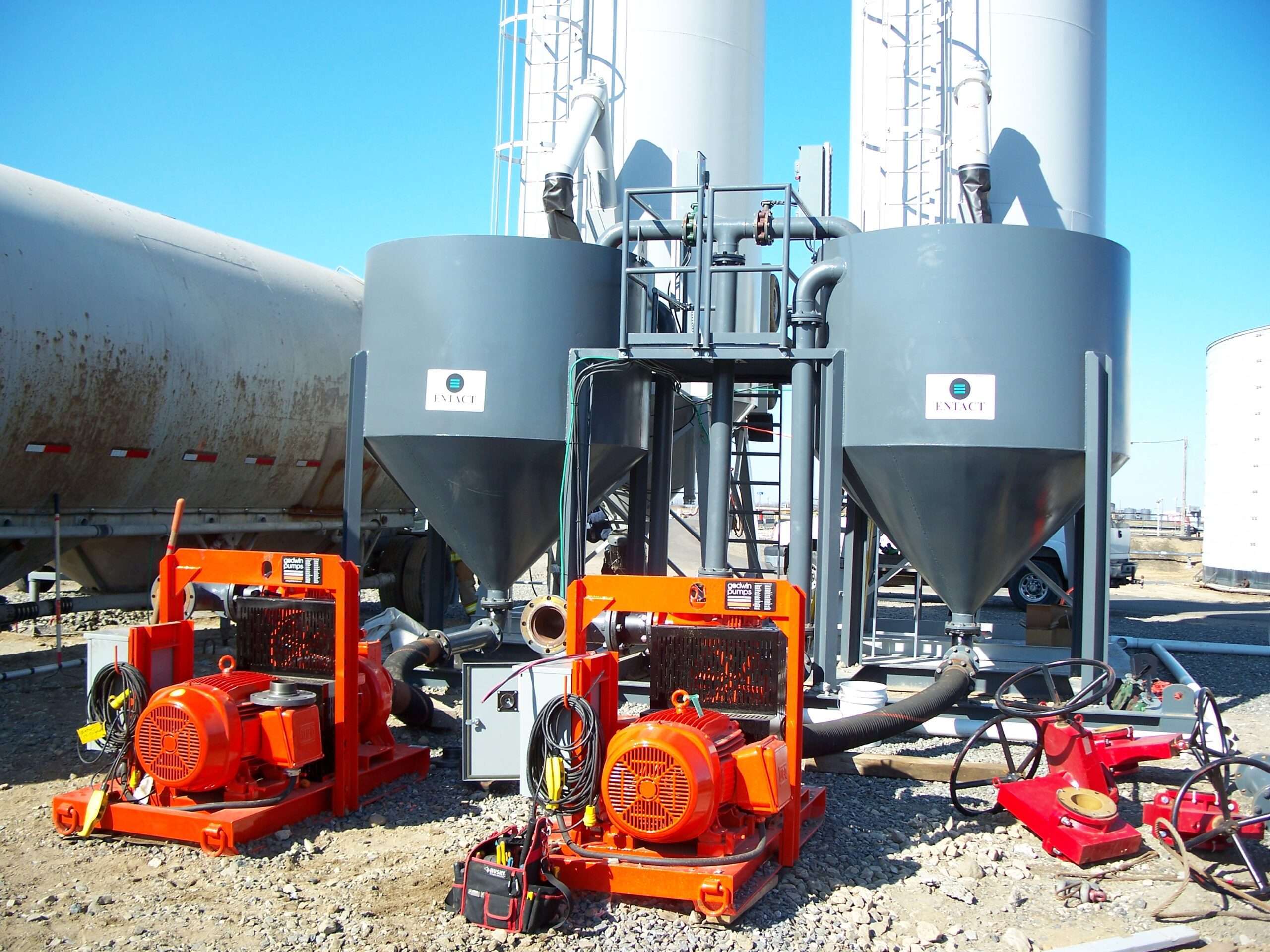
Additives Used in Deep Soil Mixing
The success of DSM hinges on the careful selection and application of additives, each imparting unique properties to the soil mixture. Here’s a closer look at some commonly used additives and their respective benefits.
Cement
Renowned for its high strength and durability, cement is a staple additive in DSM applications. When mixed with soil, cement forms stable bonds that enhance cohesion, shear strength, and long-term stability. This makes it an ideal choice for stabilizing loose or granular soils and improving overall foundation performance.
Ground Granular Blast Furnace Slag (GGBFS) or Bentonite
As versatile additives, both GGBFS and Bentonite when blended with cement offers multiple benefits in DSM, including soil stabilization as well as leachability and permeability reduction, and pH adjustment. Cement-GGBFS mixtures are also used where soils contain high concentrations of sulfates and chlorides for heave and swell mitigation.
Polymer-Based Additives
Engineered to meet specific performance requirements, polymer-based additives offer tailored solutions for DSM applications.
Frequently asked questions
DSM can be performed at various depths, depending on project requirements and soil conditions. Vertical auger mixing can reach significant depths, while excavator bucket mixing is suitable for shallower applications.
The time required for DSM to achieve full strength depends on factors such as binder type, soil composition, and environmental conditions. Typically, significant strength gains can be observed within days to weeks after mixing.
DSM can be applied to a wide range of soil types, including cohesive soils, granular soils, and contaminated soils. However, the effectiveness of DSM may vary depending on soil characteristics and project-specific factors.
DSM can contribute to environmental sustainability by remediating contaminated sites, preventing the migration of pollutants into groundwater, minimizing odor generation during treatment, and minimizing site disturbance compared to traditional remediation methods.
Yes, DSM can be used in conjunction with other techniques to achieve specific project objectives or address more complex soil conditions.
ENTACT and our soil specialists can assess your site conditions, soil properties, and project requirements to provide expert guidance on whether DSM is necessary or beneficial for your project.
